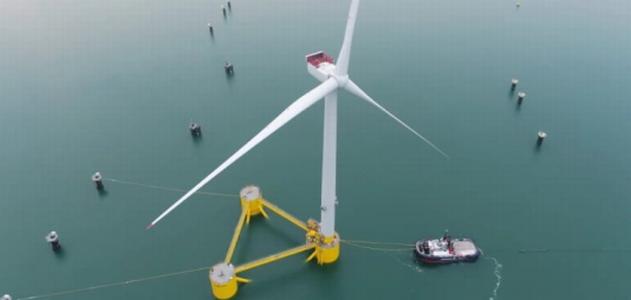 The world’s largest offshore floating wind farm has begun operation off Kincardine, approximately 15 kilometers off the southeast coast of Aberdeenshire, Scotland, at water depths ranging between 60 and 80 meters. The five floating turbines are expected to generate up to 218GWh of clean electricity per year, an output that will be enough to power approximately 55,000 households.
The world’s largest offshore floating wind farm has begun operation off Kincardine, approximately 15 kilometers off the southeast coast of Aberdeenshire, Scotland, at water depths ranging between 60 and 80 meters. The five floating turbines are expected to generate up to 218GWh of clean electricity per year, an output that will be enough to power approximately 55,000 households.
The project was developed by Kincardine Offshore Wind, a wholly-owned subsidiary of Pilot Offshore Renewables (POR). Cobra Wind, a subsidiary of ACS Group, is responsible for the engineering, design, supply, construction, and commissioning of the Kincardine floating wind farm.
Statkraft, a renewable energy generator owned by the Norwegian state, will buy the entire electrical output of the 48 MW Kincardine Offshore Wind Farm through a power purchase agreement that extends until 2029.
World-Energy.org reports that the five floating turbines are registered under the flag of the Republic of the Marshall Islands (RMI), which has been actively involved in this project as they worked closely with the American Bureau of Shipping (ABS) to determine the applicable requirements of the International Maritime Organization (IMO).
Matthew Tremblay, ABS Senior Vice President for Global Offshore, highlighted the potential of floating turbines: “We are confident that they will have an increasingly prominent role to play in the development of sustainable energy around the world.” He also highlighted ABS’s role as a “world leader in classifying floating offshore wind”, stating that “we can use this extensive experience to support the safe development of the floating offshore wind energy industry.”
Most offshore wind farms are fixed to the ocean floor, which limits where the turbines can be placed. Installation and assembly of fixed installations can be costly. Floating turbine installations can be fabricated in port and towed to deeper waters where winds are often stronger and steadier than shallower water locations. Anchoring the floating wind farms can have less of an environmental impact as compared to the installation of fixed turbines.
